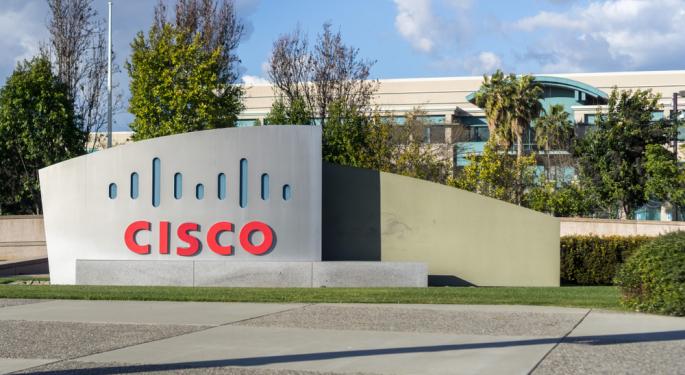Cisco Is Quietly Beating The AI Hype—Should Investors Pay Closer Attention?
Cisco Systems (NASDAQ:CSCO) stock is up ~14% year-to-date, gaining ~18% in the last three months. During the same period, the NASDAQ Composite Index (which includes Cisco) gained over 7% and 23%. The stock trades close to its 52-week high of $69.78.
Cisco earns most of its revenue by selling networking hardware and software—such as routers, switches and wireless devices—along with a wide range of services and software-based solutions.
Also Read: Cisco’s Partners With AIP In Latest AI Push
These offerings cover cloud computing, cybersecurity, mobile connectivity, collaboration tools, video and data analytics. The company also generates recurring revenue through its subscription-based services.
Cisco’s Growth Drivers
In February, Wall Street analysts highlighted Cisco’s building momentum with strong AI-driven demand, upbeat guidance and solid fundamentals after its second-quarter results. Analysts, including from JPMorgan and Piper Sandler, called Cisco well-positioned to meet rising AI and networking demand across the Cloud, Enterprise and Service Provider sectors. They expect continued growth into 2026, fueled by product launches, Security and Observability momentum and Splunk synergies.
Also, in February, JPMorgan noted that companies like Cisco and Arista Networks (NYSE:ANET) must move quickly to protect their market share as Nvidia (NASDAQ:NVDA) strengthens its control over the AI infrastructure stack. While the demand for AI networking is rising, Nvidia’s Spectrum-X is gaining traction with major customers like Microsoft (NASDAQ:MSFT) and Oracle (NYSE:ORCL). JP Morgan’s Samik Chatterjee expects networking players to face growing pressure as Nvidia expands its reach, especially with upcoming products like Blackwell Ultra set to push AI compute demand even higher.
In March, JPMorgan noted that Cisco and Arista are better equipped to handle industry headwinds like tariffs and federal budget cuts, backed by their software-heavy business models and ability to pass on costs, giving them an edge over more commoditized hardware firms.
While federal spending slowdowns could create short-term pressure—especially for Cisco, with over 5% of revenue tied to government contracts—JPMorgan expects long-term gains as federal agencies modernize IT infrastructure. Overall, software-focused, infrastructure-driven firms like Cisco are best positioned to weather the current turbulence, according to the firm.
Latest Quarterly Results
On May 14, Cisco reported third-quarter revenue of $14.15 billion (up from $12.70 billion a year ago), which beat the Street estimate of $14.08 billion.
Cisco reported a 20% Y/Y increase in product orders, or 9% growth excluding Splunk, with gains across all regions and customer segments. The company also secured over $600 million in AI infrastructure orders from webscale customers, beating its $1 billion target one quarter ahead of schedule.
Cisco sees fourth-quarter revenue of $14.5 billion-$14.7 billion, versus the $14.58 billion estimate. Cisco raised its fiscal 2025 revenue forecast from $56 billion-$56.50 billion to a new range of $56.5 billion-$56.7 billion, versus the $56.47 billion estimate.
Wall Street firms, including Rosenblatt and Goldman Sachs, noted that higher-than-expected revenue from Networking and Collaboration helped offset a shortfall in Security. They also called out the company’s expanding gross margins and lighter tariff impact for the beat. The analysts highlighted Cisco’s fourth-quarter revenue guidance of $14.6 billion, which surpassed expectations. They said the company is outpacing Arista in the AI cycle by becoming more responsive to hyperscale customers.
Price Action: CSCO stock is up 0.13% at $67.27 premarket at the last check on Wednesday.
Read Next:
Photo: Shutterstock
© 2025 Benzinga.com. Benzinga does not provide investment advice. All rights reserved.



